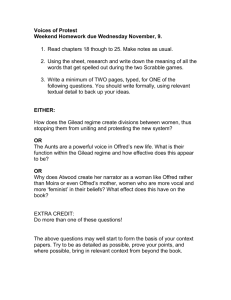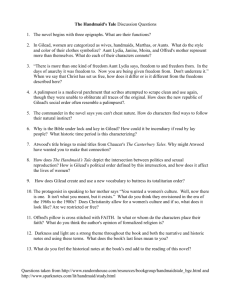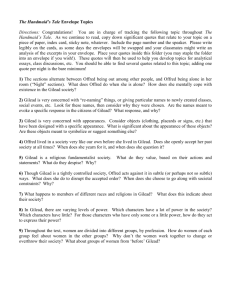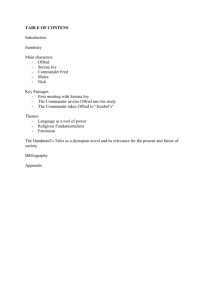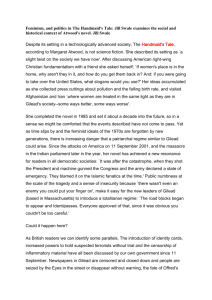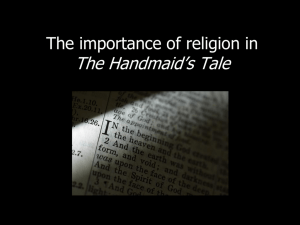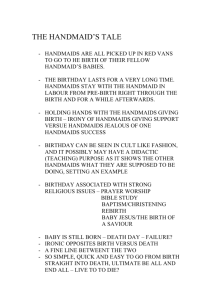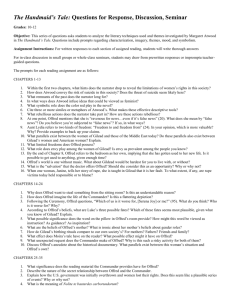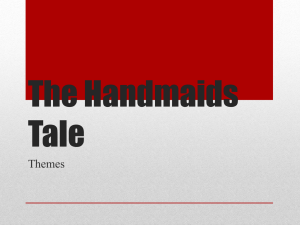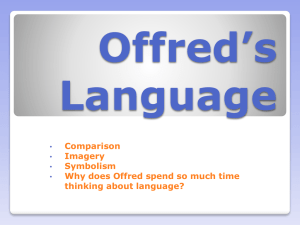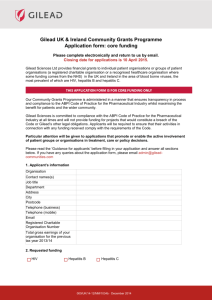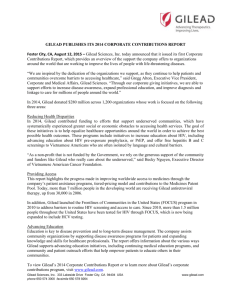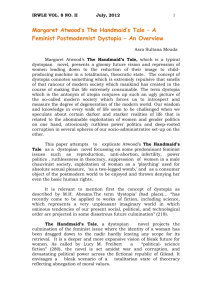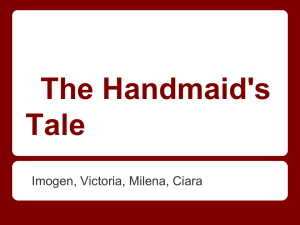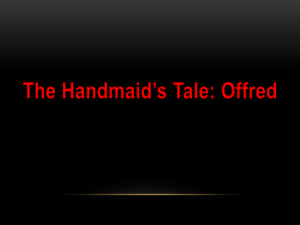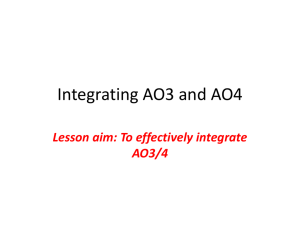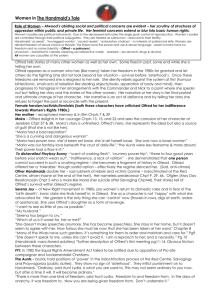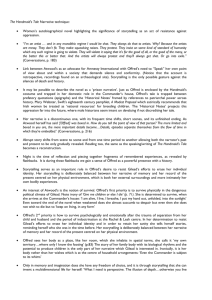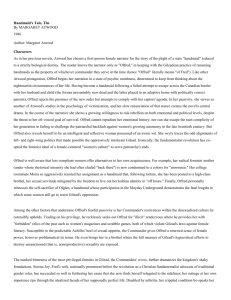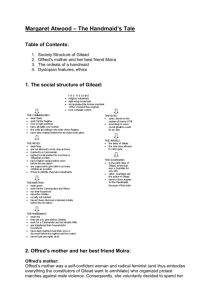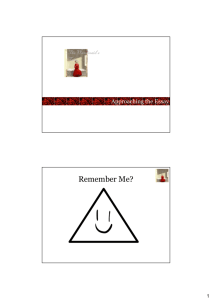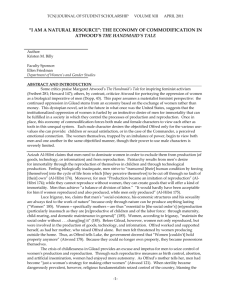A Handmaid`s Tale Essay/Study Questions
advertisement
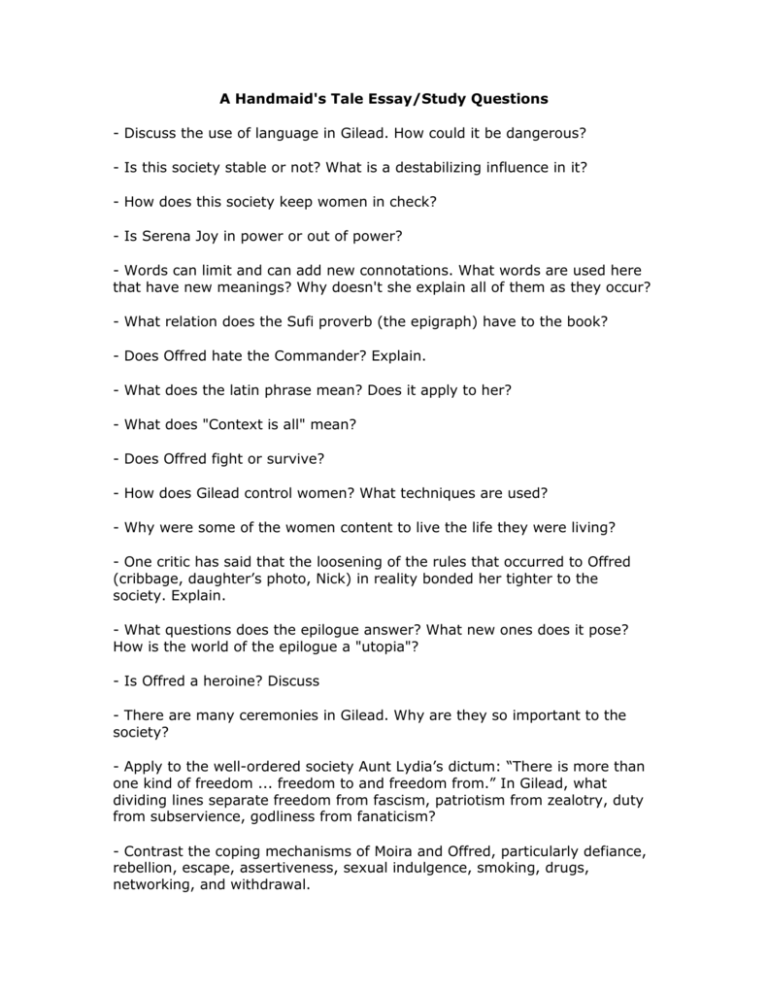
A Handmaid's Tale Essay/Study Questions - Discuss the use of language in Gilead. How could it be dangerous? - Is this society stable or not? What is a destabilizing influence in it? - How does this society keep women in check? - Is Serena Joy in power or out of power? - Words can limit and can add new connotations. What words are used here that have new meanings? Why doesn't she explain all of them as they occur? - What relation does the Sufi proverb (the epigraph) have to the book? - Does Offred hate the Commander? Explain. - What does the latin phrase mean? Does it apply to her? - What does "Context is all" mean? - Does Offred fight or survive? - How does Gilead control women? What techniques are used? - Why were some of the women content to live the life they were living? - One critic has said that the loosening of the rules that occurred to Offred (cribbage, daughter’s photo, Nick) in reality bonded her tighter to the society. Explain. - What questions does the epilogue answer? What new ones does it pose? How is the world of the epilogue a "utopia"? - Is Offred a heroine? Discuss - There are many ceremonies in Gilead. Why are they so important to the society? - Apply to the well-ordered society Aunt Lydia’s dictum: “There is more than one kind of freedom ... freedom to and freedom from.” In Gilead, what dividing lines separate freedom from fascism, patriotism from zealotry, duty from subservience, godliness from fanaticism? - Contrast the coping mechanisms of Moira and Offred, particularly defiance, rebellion, escape, assertiveness, sexual indulgence, smoking, drugs, networking, and withdrawal. - Study the stratification of female society in Gilead. Note the duties and significance of Unwomen, Wives, Daughters, Econowives, Handmaids, Marthas, and Aunts. - How does The Handmaid’s Tale depict the intersection between politics and sexual reproduction? How is Gilead’s political order defined by this intersection, and how does it affect the lives of women? - How does Gilead create and use a new vocabulary to buttress its totalitarian order? - Discuss the role of the Aunts and of Serena Joy in the novel. How do they relate to other women, and how does this make them fit into the hierarchy of Gilead? - Is the Commander a sympathetic character, a monster, or both? - Is Atwood’s novel ultimately a feminist work of literature, or does it offer a critique of feminism? - What role does Moira play in the novel? How does her significance change as the story progresses? - Discuss the various ways in which Atwood uses setting and environment to highlight Gilead’s oppression. - What extra dimension do the Historical Notes add to the story? - “From fear to defiance.” Is that a correct characterization of Offred’s progress in the novel? - How does the Gilead regime use language, especially Biblical language, to solidify its power? - Throughout The Handmaid's Tale Offred considers the multiple meanings and connotations of specific words. What might Atwood be suggesting about the flexibility or lack of specificity of language? What does this obsession with words convey about Offred's character or situation? - How does the Gileadean government use the constant potential of surveillance to keep its citizens in line? Do you think Offred should have taken more risks to better her situation, or was she doing the best she could given the circumstances? - In an interview, Atwood said that "This is a book about what happens when certain casually held attitudes about women are taken to their logical conclusions. For example, I explore a number of conservative opinions still held by many - such as a woman's place is in the home. And also certain feminist pronouncements - women prefer the company of other women, for example. Take these beliefs to their logical ends and see what happens." How does the world of Gilead contain elements of extremely conservative, religious beliefs, as well as elements of more liberal, feminist beliefs? Do you think Atwood accomplished her goal? - One of the main goals of the Gilead Regime seems to be to control and regulate sex and sexuality. Do you think they succeed? Are sexual relations more ordered and "normalized" under the new regime? - The Handmaid's Tale is set in Cambridge, Massachusetts, and most of the buildings and landmarks mentioned throughout the novel are parts of Harvard University. Why might Atwood have chosen a major university as the headquarters of this new regime? In your answer, consider the relationship between knowledge and control. - In his keynote speech, Professor Pieixoto tells his audience that "we must be cautious about passing moral judgment upon the Gileadeans" because "we have learned by now that such judgments are of necessity culturespecific." Do you agree? Explain your critique or defense of the Gileadean rule. - Why is the hotel where Moira is kept known as "Jezebel's"? How does this name fit in with the Gileadean's tendency to place the primary responsibility on women for any sexual problems or deviancy? - Atwood chose not to follow a strictly chronological pattern in the telling of Offred's story. Why do you think she did so? What does it add and what are its disadvantages? - Aunt Lydia says to the Handmaid-trainees, “We were a society dying of too much choice.” How does this relate to her distinction between freedom from and freedom to? What freedoms does Gilead claim to be providing its citizens? What freedoms are being denied? - Consider the naming of the Handmaids, ‘Offred’, ;Ofwarren’, and ‘Ofglen’, for example. What does this reveal about the values and power dynamics of Gilead? What parallels can be made between the naming system of their society and the naming of women in our society? - Each category of women in Gilead is resentful of the others. Explain the reasons for this resentment and discuss its ultimate effect. - How does Gilead’s policing of language help to control the thoughts of its citizens? For example, why is Offred so shocked when her doctor uses the word ‘sterile’ in reference to men? - Offred’s narration is made up of a confusing mix of details from the present tense action of the novel and details from her various memories of the past. In what ways are her memories connected to what is happening to her at the Commander’s house? Why has Atwood chosen a narrative style that so frequently blurs distinctions between present and past? - Discuss ways in which Gilead demonstrates that it is a patriarchal misogynic society, and its justification for this. - Discuss the various ways Gilead turns its people’s anger and frustration away from the regime and onto some safe target a scapegoat. - Sexism and misogyny exist when women are not granted the same rights as men, when women are restricted to the domestic sphere, and when women are valued primarily for their functionality rather than their humanness. Consider the way sexism and misogyny share the culture of Gilead as well as societies that precede and follow it. - In The Handmaid’s Tale, Margaret Atwood presents a first person narrator who chronicles her experiences under an extremely oppressive, misogynistic regime. Explore the development of this character during the course of her narrative. Does she move from fear and intimidation to the liberation of her will, or is the character formation more complicated in this text?
